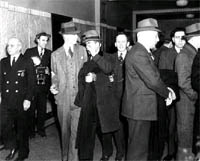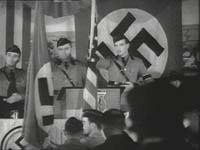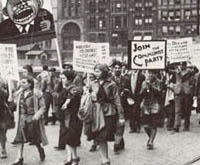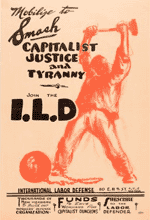Mafia:
 With alcohol being made illegal through Prohibition, the public
turned to the criminal element to supply them with their
spirits. Gang warfare during Prohibition over territory between
the Sicilian, Jewish, and Irish Gangs left many dead and the Mafia
on top. With alcohol being made illegal through Prohibition, the public
turned to the criminal element to supply them with their
spirits. Gang warfare during Prohibition over territory between
the Sicilian, Jewish, and Irish Gangs left many dead and the Mafia
on top.
The largest syndicate during
the Dirty 30s! is the Mafia, with their influence being felt throughout major cities
across the United States. During prohibition the mafia had a monopoly on bootleg
liquor and a controlling interest in loan sharking & gambling. In
the early 30s with the end of prohibition in sight, a war broke out
in the mafia ranks which lead to new leadership and a new direction
for the mafia which included prostitution and the heroin trade.
The Mafia is set up in a hierarchy,
being held together with strongly enforced bonds of honor and
loyalty, which included the Omerta, a code of silence that is a
promise not to reveal any Mafia secrets or members even under threat
of torture or death (See Murder Inc., below). Within this hierarchy
are several smaller gangs that keeps the leaders as
far away from the crimes as possible.
Some of these leaders moved into the limelight
and gained celebrity status as "Public Enemies".
Murder Inc., a Murder-for-Hire gang
responsible for the killing of dispensable lackeys and informers,
was the enforcement arm of the syndicate, meaning they didn't kill
anyone outside of the organization.
The Teamsters Union's upper echelon was heavily influenced by the Mafia
in the 1930s, and the United States
government encouraged its involvement as a way to battle the
influence of the communists & the CIO (Congress of Industrial
Organizations).
Nazis:
 Though not a major force in America, they still had a presence
here and groups of pro Nazi
supporters tried to influence policies. The most notorious being the
"German-American bund" lead by Fritz Kuhn. The bund,
organized in 1936, had evolved from a series of nationwide
German-American groups that formed following World War I. These groups
envisioned a day when the US would be ruled by Nazism. Though not a major force in America, they still had a presence
here and groups of pro Nazi
supporters tried to influence policies. The most notorious being the
"German-American bund" lead by Fritz Kuhn. The bund,
organized in 1936, had evolved from a series of nationwide
German-American groups that formed following World War I. These groups
envisioned a day when the US would be ruled by Nazism.
In 1936 the German-American
bund developed Camp Siegfried
on Long Island, NY where they proclaim in a brochure that ''You will
meet people who think as you do.'' By 1937, up to 40,000 bundists
would arrive at the camp. It was from this camp that the Nazis party
itself is believed to set
up operations. Those joining the bund were required to swear an oath
of allegiance to Hitler.
Though Kuhn
claimed to have over 480,000 followers, records show they only had
8500 members and 5000 "sympathizers".
Overseas, however, the Nazi party
was gaining strength and by
1939 they had invaded Poland and started WWII.
Communists:
 Believing Karl Marx's prediction
about the fall of capitalism, communists envisioned the overthrow the capitalist system and
implementing the communist one. Believing Karl Marx's prediction
about the fall of capitalism, communists envisioned the overthrow the capitalist system and
implementing the communist one.  The communists
strongly influenced the union movement, rising through the ranks of
the CIO, organizing labor strikes and urging black and white
workers to 'unite and fight'. Blacks were heavily recruited, citing
the same hardships that the two groups shared. The communists
strongly influenced the union movement, rising through the ranks of
the CIO, organizing labor strikes and urging black and white
workers to 'unite and fight'. Blacks were heavily recruited, citing
the same hardships that the two groups shared.
In the 1930s the communists
spearheaded a broad-based American movement that tried to separate itself from the Soviet model. The
Popular Front allied with non-communists in the political and
economic arenas, specifically the Democratic party, to garner more
strength.
Hollywood
leftists embraced the Popular Front movement with open arms and
donated heavily to their cause. The communists used this newfound
alliance as a way to control the
movie industry.
The
influence of the communists & socialists in some of the New Deal programs
were seen as a partial success, but the revolution they had hoped
for never materialized.
Ku Klux Klan (KKK):
 Organized in 1865, The Klan is alive an well in the Dirty 30s!
though their numbers have dwindled from 4,000,000 at their peak in
1925 to 30,000 in the 1930s after the conviction of Klan
leader, David C. Stephenson for second-degree murder in 1925. Those
that remained with the organization terrorized new immigrants, blacks and
Catholics,
while complaining that the government had too many Jews and
Catholics. Organized in 1865, The Klan is alive an well in the Dirty 30s!
though their numbers have dwindled from 4,000,000 at their peak in
1925 to 30,000 in the 1930s after the conviction of Klan
leader, David C. Stephenson for second-degree murder in 1925. Those
that remained with the organization terrorized new immigrants, blacks and
Catholics,
while complaining that the government had too many Jews and
Catholics.
Klan factions in the North formed a loose bond with the Nazi party and are commonly found
in union busting actions. Towards the end of the 1930s they focused
on communism, using the "red scare" as their battle cry.
|

 With alcohol being made illegal through Prohibition, the public
turned to the criminal element to supply them with their
spirits. Gang warfare during Prohibition over territory between
the Sicilian, Jewish, and Irish Gangs left many dead and the Mafia
on top.
With alcohol being made illegal through Prohibition, the public
turned to the criminal element to supply them with their
spirits. Gang warfare during Prohibition over territory between
the Sicilian, Jewish, and Irish Gangs left many dead and the Mafia
on top.
 Though not a major force in America, they still had a presence
here and groups of pro Nazi
supporters tried to influence policies. The most notorious being the
"German-American bund" lead by Fritz Kuhn. The bund,
organized in 1936, had evolved from a series of nationwide
German-American groups that formed following World War I. These groups
envisioned a day when the US would be ruled by Nazism.
Though not a major force in America, they still had a presence
here and groups of pro Nazi
supporters tried to influence policies. The most notorious being the
"German-American bund" lead by Fritz Kuhn. The bund,
organized in 1936, had evolved from a series of nationwide
German-American groups that formed following World War I. These groups
envisioned a day when the US would be ruled by Nazism.  Believing Karl Marx's prediction
about the fall of capitalism, communists envisioned the overthrow the capitalist system and
implementing the communist one.
Believing Karl Marx's prediction
about the fall of capitalism, communists envisioned the overthrow the capitalist system and
implementing the communist one.  The communists
strongly influenced the union movement, rising through the ranks of
the CIO, organizing labor strikes and urging black and white
workers to 'unite and fight'. Blacks were heavily recruited, citing
the same hardships that the two groups shared.
The communists
strongly influenced the union movement, rising through the ranks of
the CIO, organizing labor strikes and urging black and white
workers to 'unite and fight'. Blacks were heavily recruited, citing
the same hardships that the two groups shared. Organized in 1865, The Klan is alive an well in the Dirty 30s!
though their numbers have dwindled from 4,000,000 at their peak in
1925 to 30,000 in the 1930s after the conviction of Klan
leader, David C. Stephenson for second-degree murder in 1925. Those
that remained with the organization terrorized new immigrants, blacks and
Catholics,
while complaining that the government had too many Jews and
Catholics.
Organized in 1865, The Klan is alive an well in the Dirty 30s!
though their numbers have dwindled from 4,000,000 at their peak in
1925 to 30,000 in the 1930s after the conviction of Klan
leader, David C. Stephenson for second-degree murder in 1925. Those
that remained with the organization terrorized new immigrants, blacks and
Catholics,
while complaining that the government had too many Jews and
Catholics.